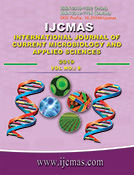


 National Academy of Agricultural Sciences (NAAS)
National Academy of Agricultural Sciences (NAAS)

|
PRINT ISSN : 2319-7692
Online ISSN : 2319-7706 Issues : 12 per year Publisher : Excellent Publishers Email : editorijcmas@gmail.com / submit@ijcmas.com Editor-in-chief: Dr.M.Prakash Index Copernicus ICV 2018: 95.39 NAAS RATING 2020: 5.38 |
The development of a protocol for biosynthesizing nanomaterial in an eco-friendly manner is a major concern in the field of microbial nanotechnology. In this study, microbial synthesis of silver nanoparticles (AgNPs) with a high level of bionanocatalytic activity was accomplished utilizing cell extracts of Penicillium digitatum FCMR-728 as the agents for reducing, capping and stabilizing. The presence of AgNPs was confirmed by an indication of a surface plasm on resonance band via UV–vis spectrum at 550 nm. Evidence of fairly uniformly spherical AgNPs being synthesized was shown by transmission electron microscopy images. The sizes of the nanoparticles increased with reaction time by an average of 5 nm to 30 nm. The formation of nanocrystalline silver particles was verified by X-ray diffraction analysis. The presence of functional groups on the surface of biosynthesized AgNPs, such as C=O, O―H, N―H, C―O―C C―H and C―OH, which play role in the AgNPs stability, was shown by Fourier transform infrared spectra. Biogenic AgNPs were utilized as bionanocatalysts for nanoreduction of 4-nitrophenol compound, where the linear correlation with AgNPs concentration of the reaction rate constant led to the rate increasing from 0.61 /min to 1.63 /min, via the AgNPs amounts increasing from 1.53×10–6 to 17.58×10–6 mM. The synthesized AgNPs also showed a very high degree (4.04×105/min/M) of normalized bionanocatalytic activity. This was significantly higher than the same activity for AgNPs that were synthesized by other traditional of chemical and biological methods. Moreover, the high toxicity of biosynthesized AgNPs against human pathogenic bacteria raises the potential for efficiently applying AgNPs as antibacterial agents.
 |
 |
 |
 |
 |